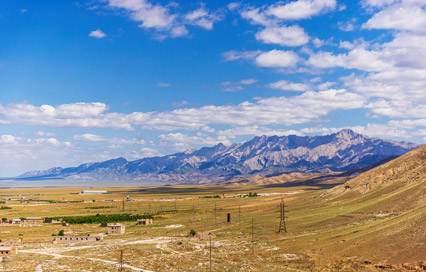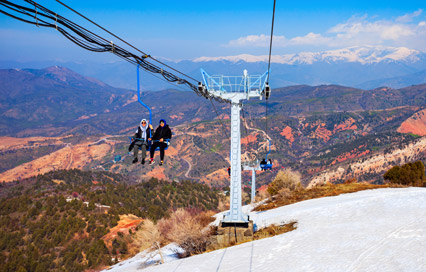Discover The Architectural Marvels Of The Silk Road Uzbekistan
October 12, 2024
Mosaic-adorned medressas, crumbling mud fortresses, desert citadels, and bustling market bazaars. The Silk Road was the world's superhighway for several centuries, and Uzbekistan at its center.
The Silk Road progressively fell out of use as trade moved from the land to the sea and then the air. Under Soviet domination, the nations and customs of Central Asia languished for many years, all but forgotten by tourists and the fluctuations of international commerce.
However, in recent years, Central Asia has started to reopen its doors to a new wave of tourists wanting to rediscover the forgotten splendor of the Silk Road. Many Silk Road destinations in Uzbekistan served as a major hub for traders and tourists plying the routes connecting the Far East with Europe, Persia, and North Africa.
For anyone interested in learning about the origins of international trade and how religious ideas, art, language, and culture spread along with it, a trip to this recently reopened country is a must. This article explores everything about Silk Road Uzbekistan.
About Uzbekistan Silk Road History
The Silk Road Uzbekistan was a network of trade routes that connected the East and West, facilitating not only commerce but also cultural exchange. Spanning over 7,000 miles, it linked China with Europe and played a crucial role in the spread of ideas, religions, and technologies. Due to its advantageous location, Uzbekistan became a major hub for trade and tourism, which sparked the growth of thriving cities that became hubs for knowledge, culture, and architecture.
Uzbekistan's architectural landscape bears the imprint of the many empires that flourished and faded along the Silk Route Uzbekistan, chief among them the Timurid, Islamic, and Persian empires. The blending of styles from different cultures produced distinctive buildings with elaborate tilework, opulent domes, and stately minarets.

The Silk Road Uzbekistan was a network of trade routes that connected the East and West
Top Cities In Uzbekistan On The Silk Road
The Silk Road, so named because of its prosperous silk trade, passed through several of the largest cities in Uzbekistan, such as Samarkand, Bukhara, and Khiva. In addition to silk, these would see the trade of valuable stones and spices as well as the interchange of culture and artistic ideas.
We've highlighted Uzbekistan Silk Road cities and the attractions along the way. For amazing travel experiences, check out our list of the top cities in Uzbekistan on the Silk Road:

Many Silk Road destinations in Uzbekistan served as a major hub for traders and tourists
Samarkand
Samarkand is the best destination if you are charmed by Uzbekistan Silk Road history and would like to learn as much as you can about the area and its history. It is among Central Asia's greatest and oldest cities. When the Greeks captured Samarkand in 329 BC, they dubbed the city Marakanda. Even Alexander the Great was taken aback by its grandeur at that same moment.
Samarkand has fascinated Silk Road traders and tourists with its own character for centuries, never losing its significance. Samarkand was well-known for its mulberry tree-derived paper and peaches. You can tour workshops that use this age-old method of making paper. The turquoise domes of Samarkand transport us back in time and remind us of the illustrious Silk Road era.

Samarkand is the best destination if you are charmed by Uzbekistan Silk Road history
Bukhara
Bukhara is one of the top Silk Road cities Uzbekistan and one of the major centers of learning and spirituality during the Islamic Golden Age. A stroll around its small city center, which features a marketplace under a dome, mosques, and madrassas, is a delightful experience.
UNESCO has recognized the entire historic centre of Bukhara as a World Heritage Site. The Kalyon minaret, which is reputed to be the sole monument spared by Genghis Khan when his army destroyed everything around it, pierces the sky above Bukhara's winding lanes.
The Kalyon mosque is the match of Bibi-Khanym in Samarkand. Constructed throughout the 12th to 16th centuries, the complex has two madrasas in addition to the well-known tower and the mosque itself.

Bukhara is one of the top Silk Road cities Uzbekistan
Khiva
Khiva's Old City resembles an outdoor museum dedicated to the Silk Road. Ichan-Kala, a little city center, lies behind its massive walls. Discovering Ichan-Kala's historic streets, scaling its towering mud walls, touring its castle, mausoleum, and mosques, and sipping tea in its teahouses are all must-do activities in this evocative location.
Khiva was a major Silk Road trade hub and was the backdrop for many marvelous stories. It is also evidence of the hard reality of living in the desert and the strict social norms that accompany it. It used to be a slave trade metropolis with harsh laws and penalties for breaking them. Khiva will reveal a realm populated by both the darkest secrets and the brightest achievements of the Silk Road Uzbekistan.

Khiva was a major Silk Road trade hub
Tashkent
The country's diversity is best showcased in the capital city of Tashkent, where both traditional and contemporary buildings coexist.
Every corner of the city has a story to tell, from its massive monuments covered in elaborate tilework to its brutalist architecture from the Soviet era. In the same way that the Silk Road of the past promoted cross-cultural interchange, Tashkent of today unites a progressive vision with its rich historical background to serve as a conduit for cross-border trade.
Modern museums and exhibition spaces coexist with the centuries-old mosques and madrasas. If you want a helpful overview of Uzbekistan and its people, an excellent place to start is the State Museum of History.
Conclusion
By visiting the remarkable Silk Road destination Uzbekistan, you can see a distinctive and unforgettable view of this Central Asian country.
These Silk Road cities in Uzbekistan offer visitors a glimpse into the past through their winding bazaars and elaborate architecture, but you should not miss the other distinctive features of Uzbekistan, such as its hearty cuisine, vividly colored textiles and intricately patterned ceramics, its enthralling art museums, and the snowcapped "heavenly mountains" of the Tian Shan range.
If you're inspired to visit Uzbekistan and explore these ancient cities along the Silk Road, you’ll need to secure a visa before your journey begins. Luckily, the process is simple and hassle-free. Uzbekistan offers an eVisa option for many travelers, allowing you to apply online and receive your visa quickly, making your travel plans smoother.
Start your journey into the heart of the Silk Road Uzbekistan today. Visit our GVC website to apply for your Uzbekistan eVisa and take the first step toward discovering the breathtaking architectural wonders of this historical treasure.
Related Articles:
- Architecture Of Uzbekistan: A Journey Through Time
- Uzbekistan's Architectural Renaissance: Blending History With Modernism
- Visiting Uzbekistan's Best Historical Sites
- The Most Famous Monuments And Landmarks To Visit In Uzbekistan
- Silk Road Architecture: Exploring Uzbekistan's Ancient Wonders
- From Silk Road To Modern Marvels: A Travelogue Of Uzbekistan And Central Asia
Tags




